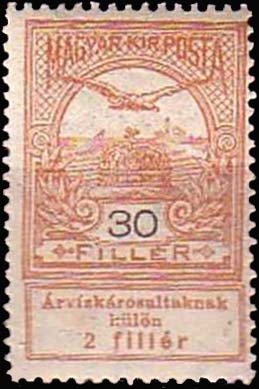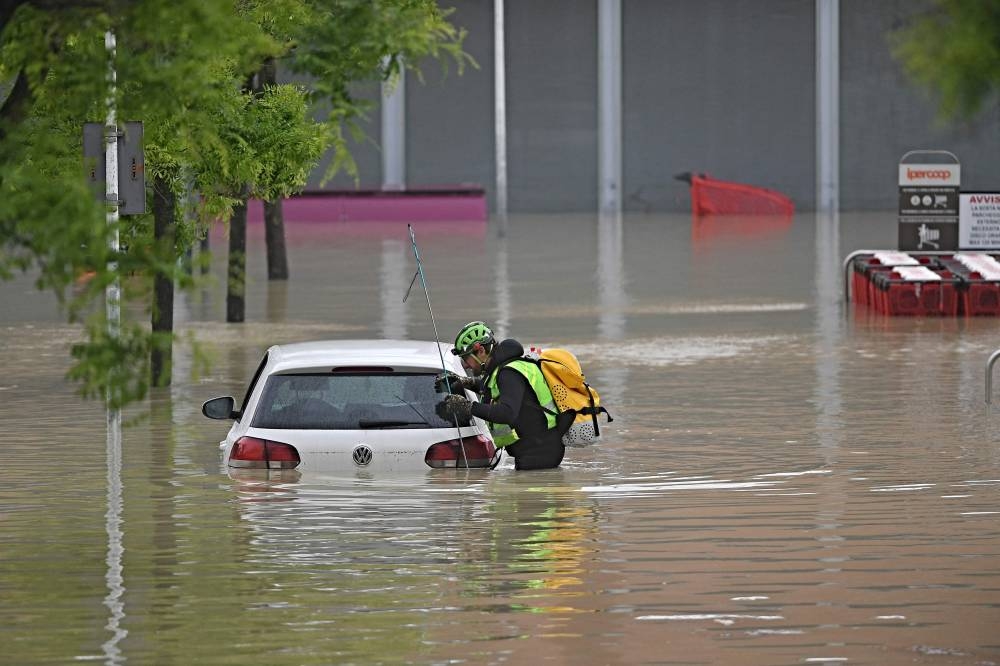Stamp: Mythical bird Turul flying over Crown of St. Stephen (Hungary 1913)
Mythical bird Turul flying over Crown of St. Stephen (Hungary 1913)
20 November (Hungary ) within release Help for East Banat Flood goes into circulation Stamp Mythical bird Turul flying over Crown of St. Stephen face value 30+2 Hungarian fillér
| Stamp Mythical bird Turul flying over Crown of St. Stephen in catalogues | |
|---|---|
| Michel: | Mi:HU 138 |
| Yvert et Tellier: | Yt:HU 116 |
Stamp is vertical format.
Wmk. 7 (Patriachs cross)Also in the issue Help for East Banat Flood:
- Stamp - Mythical bird Turul flying over Crown of St. Stephen face value 1+2;
- Stamp - Mythical bird Turul flying over Crown of St. Stephen face value 2+2;
- Stamp - Mythical bird Turul flying over Crown of St. Stephen face value 3+2;
- Stamp - Mythical bird Turul flying over Crown of St. Stephen face value 5+2;
- Stamp - Mythical bird Turul flying over Crown of St. Stephen face value 6+2;
- Stamp - Mythical bird Turul flying over Crown of St. Stephen face value 10+2;
- Stamp - Mythical bird Turul flying over Crown of St. Stephen face value 12+2;
- Stamp - Mythical bird Turul flying over Crown of St. Stephen face value 16+2;
- Stamp - Mythical bird Turul flying over Crown of St. Stephen face value 20+2;
- Stamp - Mythical bird Turul flying over Crown of St. Stephen face value 25+2;
- Stamp - Mythical bird Turul flying over Crown of St. Stephen face value 30+2;
- Stamp - Mythical bird Turul flying over Crown of St. Stephen face value 35+2;
- Stamp - Mythical bird Turul flying over Crown of St. Stephen face value 50+2;
- Stamp - Mythical bird Turul flying over Crown of St. Stephen face value 60+2;
- Stamp - King Franz Josef (1830-1916) face value 1+0.02;
- Stamp - King Franz Josef (1830-1916) face value 2+0.02;
- Stamp - King Franz Josef (1830-1916) face value 5+0.02;
Stamp Mythical bird Turul flying over Crown of St. Stephen it reflects the thematic directions:
Myth is a genre of folklore consisting primarily of narratives that play a fundamental role in a society. For scholars, this is very different from the vernacular usage of the term "myth" that refers to a belief that is not true. Instead, the veracity of a myth is not a defining criterion
Birds (Aves), a subgroup of Reptiles, are the last living examples of Dinosaurs. They are a group of endothermic vertebrates, characterised by feathers, toothless beaked jaws, the laying of hard-shelled eggs, a high metabolic rate, a four-chambered heart, and a strong yet lightweight skeleton. Birds live worldwide and range in size from the 5 cm (2 in) bee hummingbird to the 2.75 m (9 ft) ostrich. They rank as the class of tetrapods with the most living species, at approximately ten thousand, with more than half of these being passerines, sometimes known as perching birds. Birds are the closest living relatives of crocodilians.
Birds of prey or predatory birds, also known as raptors, are hypercarnivorous bird species that actively hunt and feed on other vertebrates (mainly mammals, reptiles and smaller birds). In addition to speed and strength, these predators have keen eyesight for detecting prey from a distance or during flight, strong feet with sharp talons for grasping or killing prey, and powerful, curved beaks for tearing off flesh. Although predatory birds primarily hunt live prey, many species (such as fish eagles, vultures and condors) also scavenge and eat carrion
A disaster is a serious problem that happens over a period of time and causes so much harm to people, things, economies, or the environment that the affected community or society cannot handle it on its own. In theory, natural disasters are those caused by natural hazards, whereas human-made disasters are those caused by human hazards. However, in modern times, the divide between natural, human-made or human-accelerated disasters is more and more difficult to draw. In fact, all disasters can be seen as human-made, due to human failure to introduce appropriate emergency management measures
A flood is an overflow of water (or rarely other fluids) that submerges land that is usually dry. In the sense of "flowing water", the word may also be applied to the inflow of the tide. Floods are of significant concern in agriculture, civil engineering and public health. Human changes to the environment often increase the intensity and frequency of flooding. Examples for human changes are land use changes such as deforestation and removal of wetlands, changes in waterway course or flood controls such as with levees. Global environmental issues also influence causes of floods, namely climate change which causes an intensification of the water cycle and sea level rise.: 1517 For example, climate change makes extreme weather events more frequent and stronger. This leads to more intense floods and increased flood risk
In British heraldry, a coronet is any crown whose bearer is less than sovereign or royal in rank, irrespective of the crown's appearance. In other languages, this distinction is not made, and usually the same word for crown is used irrespective of rank (German: Krone, Dutch: Kroon, Swedish: Krona, French: Couronne, etc.) In this use, the English coronet is a purely technical term for all heraldic images of crowns not used by a sovereign, and implies nothing about the actual shape of the crown depicted. A Coronet is another type of crown, but is reserved for the lower ranks of nobility like Marquesses and Marchionesses, Earls and Countesses, Barons and Baronesses, and some Lords and Ladies. The specific design and attributes of the crown or coronet signifies the hierarchy and ranking of its owner.







